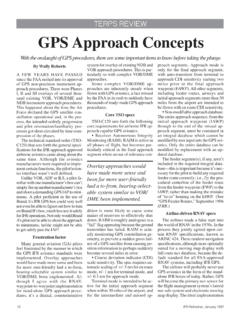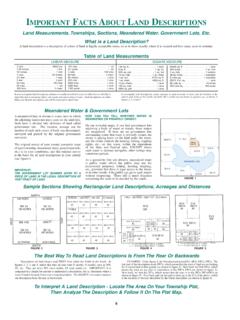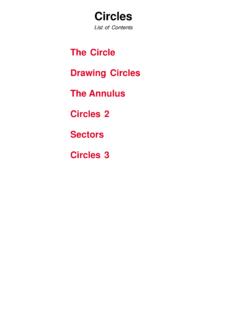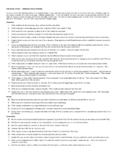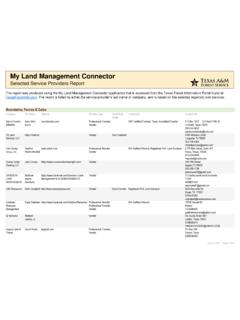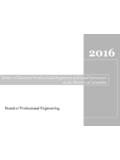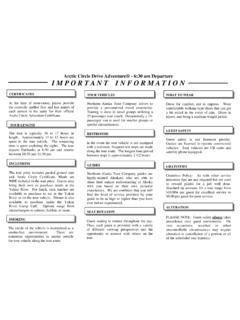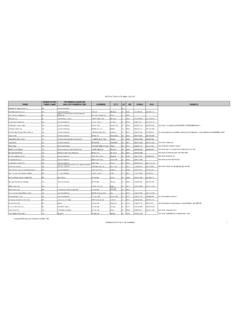Transcription of TERPS REVIEW Circle-To-Land Tactics
1 TERPS REVIEWC ircle-To- land TacticsThe circling maneuver varies widely, from almost a straight-in to a large visual Refresher, November 1997 Figure 1. Circling approach pro-tected airspace varies by aircraftcategory. The HAA must be at least350 feet for Cat A, 450 feet for B &C, and 550 feet for D & Wally RobertsTHE CIRCLING MANEUVER ISone of the more demanding aspectsof instrument flying. This is espe-cially true when the ceiling is nearMDA, the visibility is near mini-mums, and there s turbulence withrain or snow thrown into the my article Circling and the Vi-sual Segment (January 1996 IFRR),I discussed the technical aspects ofcircling approach design.
2 This articlewill REVIEW the fundamentals andprovide a more technique-orientedperspective than the previous 1 (below right) is from theAIM and shows how the circling ma-neuvering area is constructed. At anairport with all five approach catego-ries, the radii and tangents must becalculated five times with larger di-mensions for each approach cat-egory. The minimum obstacle clear-ance within each approach categorycircling maneuvering area is 300 , the height above airport(HAA) of the MDA cannot be lessthan: Cat A 350 feet, Cats B and C 450 feet, and Cats D and E 550feet.
3 These minimum HAAs for cir-cling are just that: minimums. Nei-ther the minimum circling HAAs northe lateral areas protected by thetable in Figure 1 are , they are biased toward op-erational necessity with the presump-tion of a high degree of pilot skilland airport familiarity. ICAO inter-national circling areas are muchlarger than those provided by theFAA, which should give you addi-tional pause about the FAA s circlingcriteria and (e)(2) requires you tokeep an identifiable part of the air-port in distinct view, except whenbanking temporarily blocks the , FAR (c) comes intoplay once you re satisfied it s timeto leave MDA because you re in theslot for the landing high MDAsThe FAA view of circling reallyonly covers circling MDAs to per-haps a few hundred feet higher thanthe standard 350/450/550.
4 Once theMDA reaches a height where youmust depart MDA much before roll-ing out on a final within the distancelimitations of your approach category( nm for Category A), then youshould think twice about circling atsuch an airport unless you knowwhere every big brick pile is you depart the circling MDA ondownwind or base, the FAA takes awalk at that point. Only where youget into the final approach area ofthe landing runway is there any of-fer of obstacle protection belowMDA. If the landing runway has aVASI or PAPI, you re in good shapeonce you re within 10 degrees of theextended runway centerline.
5 Also, ifthe runway has approach lights andstraight-in minimums on a differentIAP of three-quarters of a mile or less,you re in good shape. (However,chances are you would have flownthe straight-in approach in this case,right?)If the landing runway has neitherVASI/PAPI nor approach lights withone-half or three-quarter milestraight-in minimums, then you re onyour own. Once you re 300 feet be-low MDA there could be anythingsticking up, even to the runwaythreshold. This is where a local pilot sknowledge equates to a big edgeover the hapless view of circlingAIM 5-4-18f.
6 States: CirclingMinimums: In some busy terminalareas, ATC may not allow circlingand circling minimums will not bepublished. Published circling mini-mums provide obstacle clearancewhen pilots remain within the appro-priate area of protection. Pilotsshould remain at or above the cir-cling altitude until the aircraft is con-tinuously in a position from which adescent to a landing on the intendedrunway can be made at a normal rateof descent using normal maneuvers. Circling may require maneuversat low altitude, at low airspeed, andin marginal weather conditions. Pi-lots must use sound judgment, havean in depth knowledge of their ca-pabilities, and fully understand theaircraft performance to determine theexact circling maneuver sinceTERPS REVIEWIFR Refresher, November 199711(continued on next page)weather, unique airport design, andthe aircraft position, altitude, andairspeed must all be considered.
7 Thefollowing basic rules apply: 1. Maneuver the shortest path tothe base or downwind leg, as appro-priate, considering existing weatherconditions. There is no restrictionfrom passing over the airport orother runways. 2. It should be recognized thatcircling maneuvers may be madewhile VFR or other flying is inprogress at the airport. Standard leftturns or specific instruction from thecontroller for maneuvering must beconsidered when circling to land . 3. At airports without a controltower, it may be desirable to fly overthe airport to observe wind and turnindicators and other traffic whichmay be on the runway or flying inthe vicinity of the airport.
8 Be careful out thereThis AIM guidance basically says, you all better be careful out there. Subparagraphs 1 and 3 are seem-ingly contradictory. If you keep inmind that subparagraph 1 is focusedon towered airports, whereas sub-paragraph 3 is not, it becomesclearer what the FAA is trying to at a busy, non-tower air-port in marginal weather is fraughtwith the hazard potential of a mid-air collision, in addition to the sub-stantial hazard of exposure to con-trolled flight into terrain during mar-ginal or minimal conditions. Whenweather conditions permit, never usethe circling MDA when a higher traf-fic pattern altitude will where you need to operateat the minimum descent altitude forcircling should you operate belowpattern altitude.
9 The circling MDAis different than a straight-in MDAin that it becomes an operational al-titude for a sometimes lengthy visualcircuit of the airport, with preciouslittle margin for error. Are you satis-fied your skills permit a sustainedvisual circuit around the airport atonly 350 - 450 feet agl, and withsome terrain or other obstacle whiz-zing by only 300 feet below you?With all this taking place at night, instrong winds, and perhaps rain orsnow with one-mile visibility? TheMDA is just that; you cannot go be-low it under any circumstances untilyou re in a position to make a nor-mal descent to landing hopefullyon, or near, sectorWhere there are really high ob-stacles on only one side of the air-port, the circling minimums will of-ten be annotated with a restriction,such as Circling not authorizedwest of Runway 18-36.
10 These notesare easy to miss. The FAA has noresponsibility for obstacles that existin such a restricted sector. You haveno business circling at an airport un-less the reasons for application ofsuch a note for that airport is obvi-ous to in mind the excluded sectormight be defined by the extendedrunway centerline of the runway towhich you re circling. Assume, es-pecially at night, that a brick wall ris-ing to infinity is just to the restrictedside of runway centerline. Slightlyundershooting your turn to final isthe best bet at such an circle -to-landFigure 2 (below left) illustrates the classic Circle-To-Land maneuverwhere the landing runway is the re-ciprocal of the runway to which theIAP leads.

